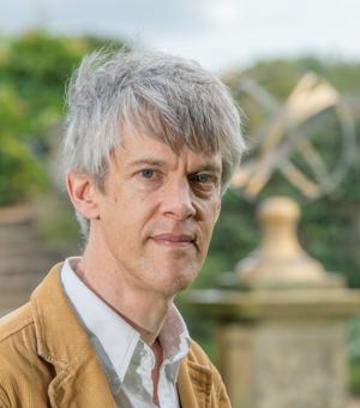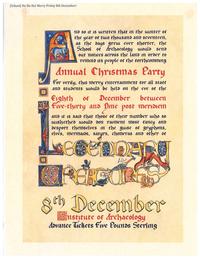Staff Spotlight: Professor Christopher Bronk Ramsey
A ten question interview with our Head of School: Professor Christopher Bronk Ramsey

Q.1. You are described on your various profile pages and public websites as a scientist, a physicist, a mathematician. What first attracted you to archaeology and what was your route into our discipline?
I was interested in archaeology as child, growing up as I did in York where the Roman and mediaeval city was so much in evidence, and just as the Viking remains below the city were being uncovered. My academic interests were primarily focussed on physics but I remember at the time being impressed by the scientific work on the glass of York Minster during school visits to the University. After reading physics here at Oxford, the chance to apply it to archaeology was very exciting, especially given all the new developments in radiocarbon at the time.
Q2. For how long have you been associated with the Oxford Radiocarbon Accelerator Unit in the School? How has the School changed in that time and where do you hope to see it in another few years?
I joined the radiocarbon lab exactly 40 years ago as a doctoral student and have remained here ever since in a number of different roles. Back then the Research Lab for Archaeology and the History of Art (such a mouthful it was always just RLAHA) was a separate entity situated partly in the physics department. Since then, things have become much more integrated across archaeology, as the nature of archaeological science has changed from the early piloting of methods to their widespread application.
The interface between disciplines continues to be my primary interest and I would like to see the School continue to pioneer approaches to studying the past in the context of contemporary science and current global challenges. I hope that this will help us to understand the world better, and to make more informed choices for the future. I think some of the current work on biocultural heritage in an excellent example of this, and something that we should be able to expand on in other ways.
Q3. Who has had the biggest influence on your career?
Early influences are often the most significant and for me, my Physics teacher at school probably had the greatest influence on how I approach things generally: he taught us always to go back to first principles if you want to understand something properly. In career terms, obviously Robert Hedges, who set up the radiocarbon lab and ran it for many years has been a central influence. Of the other people I knew from the early days of radiocarbon, I would single out a physicist Roy Middleton from the University of Pennsylvania: he was a very skilled experimentalist who was extraordinarily generous with his time and ideas. He developed ion beam techniques which still underpin many instruments like those used for radiocarbon. He was from a generation of truly collaborative researchers in physics, and a huge help to me in my doctoral research. The final influence I would like to highlight is someone I have never met: Donald Knuth, the creator of TeX and LaTeX - a program which has transformed the way people work in far more productive ways than the software outputs of huge corporations! The computer program OxCal, which I wrote to provide a flexible way to put together chronological models, in its small way is very much inspired by his work.
Q4. Do you think the public perception of archaeology appreciates how scientific a discipline it has become?
Probably not, but the reasons for that are complicated. Lots of people have done great work to promote science in archaeology but the success often depends on how visually interesting it is, and on how easy the science is to understand for someone without a scientific background. We clearly need to express things in terms of narratives on a human level to make them widely appreciated.
Q5. What is going to be the next big scientific technique, method or research focus in archaeological dating?
We all wish we knew that. An increased ability to date at very high precision, either through annual records of radiocarbon or isotope enabled dendrochronology is one key trend. More generally new methods for dating the samples you are actually interested in rather than by association is changing our interpretation of many archaeological research topics. These changes are gradual but still have the capability to be transformative. However, there may be something totally new which I have not anticipated!
Q6. What would you say to persuade current students of physics and mathematics to convince them to explore applications of their disciplines to archaeology?
I think the approaches needed are multi-faceted. In the first instance the scientists need to be able to see that deep understanding often comes from a cross-disciplinary approach. A proper appreciation of the history of science would be good – as perhaps would be a broader education to 18 than we have in much of the UK. In terms of attracting people to archaeology specifically, I think it worth remembering that archaeological jargon is just as off-putting to hard scientists as mathematical formulae might be to some archaeologists. Dialogue will only be possible if people express themselves clearly.
Q7. What non-archaeological book have you recently read and what was the last television series you streamed?
Most recently “Siena: The Life and Afterlife of a Medieval City” by Jane Stevenson. This partly reflects a general interest in the development of the Renaissance in Europe and the ways in which study of the past, often first through extant archaeological remains, prompted an explosion of artistic and scientific innovation. In terms of fiction I think the last book I finished was “A Gentleman in Moscow” by Amor Towles – a great story of how to cope with feeling constrained by circumstances. I don’t really watch television much at all, except for occasional major events: if I want to relax that is more through music – both listening and attempts to play around on various instruments.

Q8. What has been your favourite theme for the School’s Christmas fancy-dress parties?
My main pleasure in School fancy-dress parties is in seeing other people’s costumes and for that the “Legendary Creatures” party was outstanding!
Q9. If you were a guest on Desert Island Discs, what luxury item would you take with you to the Island? (In accordance with the DI rules you can’t use it to escape or communicate).
A classical guitar, hopefully with some music and spare strings. Perhaps a spell on a desert island would be an opportunity to learn to play properly. Hopefully that would be quiet enough not to count as communication.
Q10. What has been the achievement of which you have been most proud so far?
I think seeing all the things other people have found to do with the OxCal program. Helping other people either through research, or through teaching, always seems more satisfying to me than any individual publications or other achievements.



